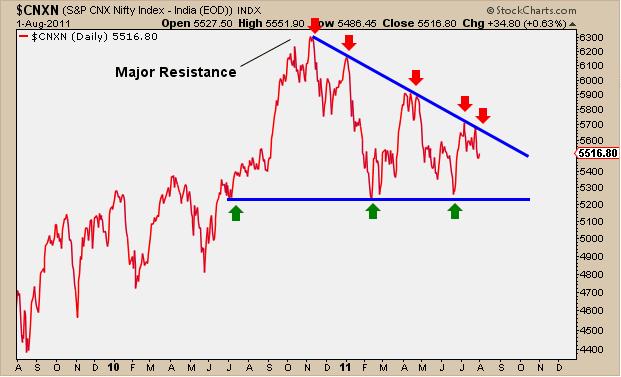2 days of rally with short covering have definitely cheered the market up. People though cautious are now pointing how much "legs" this rally have. I have been hearing targets ranging from 5300 to 5500. Though not impossible, it looks quite improbable that we will go there without having a scare again!
Its always either the "world is going to end" when stocks fall or "party as if there is no tomorrow" when stocks rally! The importance of level head is ever higher in these kinds of mood. Anyway, what I am trying to say is that, though the Nifty rallied hard in 2 days, its important not to get carried away in the euphoria. There is hardly any change in fundamentals and its just that people got too pessimistic and stocks got too oversold that this rally is taking place. Market never likes people on one side of the trade, I think shorting and making money was getting easier by the day and hence such a rally was necessary!
Coming to technicals, and doing pure price analysis, what I feel is that there has to be some kind of bottoming and consolidation, before we can say that, the bottom is in place. There has to be atleast a "higher low" to get a confirmation of it.
Above is the daily chart of Nifty from November 2010 high, and I have marked 3 earlier slides in Nifty and the "basing" it did after those ended.
The 1st and 2nd basing are quite similar, after the relentless correction, you see a strong rebound, only to give up almost all the gains in quick time. The rebound sees oscillator to get into overbought zone and the next leg of correction brings it back to the oversold territory. We also see a lower negative momentum when Nifty falls back.
The 3rd basing is quite different, as after the initial rebound Nifty makes a new low, though with lower negative momentum. Which is generally called positive divergence. The oscillator though gets deeper into oversold region.
The current rebound is only 2 days old while all previous tops have been made around 6th to 7th day. It has already done roughly 30% of the correction. Another point to note will be that this correction has been with the highest momentum since the November Top. Keeping all these factors in mind, I feel that we have some more days of rally pending and going by the average 40% rebound, we should be somewhere around 5100-5150 before this rally fades. It would be interesting to see if we make a new low or a higher low. Going by momentum of fall, I feel we can make a lower low. Lets see how this plays out, but one thing is for sure, expect a lot of volatility and whipsaws in near future!
Its always either the "world is going to end" when stocks fall or "party as if there is no tomorrow" when stocks rally! The importance of level head is ever higher in these kinds of mood. Anyway, what I am trying to say is that, though the Nifty rallied hard in 2 days, its important not to get carried away in the euphoria. There is hardly any change in fundamentals and its just that people got too pessimistic and stocks got too oversold that this rally is taking place. Market never likes people on one side of the trade, I think shorting and making money was getting easier by the day and hence such a rally was necessary!
Coming to technicals, and doing pure price analysis, what I feel is that there has to be some kind of bottoming and consolidation, before we can say that, the bottom is in place. There has to be atleast a "higher low" to get a confirmation of it.
Above is the daily chart of Nifty from November 2010 high, and I have marked 3 earlier slides in Nifty and the "basing" it did after those ended.
The 1st and 2nd basing are quite similar, after the relentless correction, you see a strong rebound, only to give up almost all the gains in quick time. The rebound sees oscillator to get into overbought zone and the next leg of correction brings it back to the oversold territory. We also see a lower negative momentum when Nifty falls back.
The 3rd basing is quite different, as after the initial rebound Nifty makes a new low, though with lower negative momentum. Which is generally called positive divergence. The oscillator though gets deeper into oversold region.
The current rebound is only 2 days old while all previous tops have been made around 6th to 7th day. It has already done roughly 30% of the correction. Another point to note will be that this correction has been with the highest momentum since the November Top. Keeping all these factors in mind, I feel that we have some more days of rally pending and going by the average 40% rebound, we should be somewhere around 5100-5150 before this rally fades. It would be interesting to see if we make a new low or a higher low. Going by momentum of fall, I feel we can make a lower low. Lets see how this plays out, but one thing is for sure, expect a lot of volatility and whipsaws in near future!
















